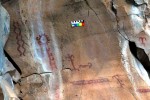 Archaeologists have discovered 3,000 rock paintings dating from the first century to the twentieth in the central Mexican state of Guanajuato, Mexico’s National Anthropology and History Institute (INAH) announced Friday. The art was found at 40 different sites in the desert region between August and October of last year, but the Institute waited to reveal the find until laboratory analyses confirmed the ages of the pictographs.
Archaeologists have discovered 3,000 rock paintings dating from the first century to the twentieth in the central Mexican state of Guanajuato, Mexico’s National Anthropology and History Institute (INAH) announced Friday. The art was found at 40 different sites in the desert region between August and October of last year, but the Institute waited to reveal the find until laboratory analyses confirmed the ages of the pictographs.
Guanajuato has been a rich source of rock art discoveries since the 1980s. In an attempt to locate and document as many of the painted sites as possible, INAH developed the Rupestral Art Project of the Victoria River Basin which has sent a team of researchers into the area for four consecutive years. This season’s find more than doubles the known rock art sites in the region from 30 to 70.
[T]he oldest images refer to rites of passage, healing, prayers for rain and mountain worship, and were created by ancient hunter-gatherer societies that occupied the area during the first centuries A.D.
These paintings, with yellow, red and black the predominating colors, generally represent human figures with headdresses, robes and shields, as well as some as yet unidentified instruments. Often in hunting and battle scenes they carry bows and arrows.
“A great diversity of animals is also to be seen, chiefly deer, canines, insects like centipedes and spiders, a great variety of birds, generally with their wings outspread, and radiating circles that probably represent the sun,” Viramontes said.
The expert said that the ancient hunter-gatherers who “created images on rockfaces were doing more than just leaving an imprint of their collective memory of historic, climatic and ritual occurrences – they painted the exposed fronts and sheltered backs of boulders as points of contact between the material and spiritual world.”
The later pictographs also include much religious symbolism, although a Christian-influenced variety courtesy of the Spanish conquistadors. The cave paintings that date to Mexico’s colonial period (1650–1810) include images of crosses, shrines and altars. They were made using white pigments characteristic of the indigenous Otomi people who settled in arid northeastern Guanajuato starting in the 16th century.
 There are also images painted in the 19th century by local ranchers. Crosses, altars and human characters predominate. The ranchers used rough strokes of red pigment as opposed to the Otomi white. They also dressed their human images in the kinds of clothes that they wore at the time: baggy pants and hats.
There are also images painted in the 19th century by local ranchers. Crosses, altars and human characters predominate. The ranchers used rough strokes of red pigment as opposed to the Otomi white. They also dressed their human images in the kinds of clothes that they wore at the time: baggy pants and hats.
The 20th century paintings are of cups and crosses. Archaeologists believe they were painted during the Cristero War (1926-1929), a rebellion against the Mexican government sparked by by President Plutarco Elías Calles’s strict enforcement of anti-clerical articles in the Mexican Constitution of 1917. According to the locals, the cave in question was used as shelter by people of various religions who also performed rituals there.
It also contains the concept painting for Houses of the Holy.
hello!
just a correction: Mexico wasn’t newly independent by 1926, the mexican independence war finished in 1821, more than 100 years before the cristero wars. you’re confusing it with the social revolution war (that started in 1910 and finished around 1924) that overthrown Porfirio Diaz, a Mexican dictator. but for then mexico was an independent country, ruled with an iron fist, but independent 🙂
Right you are. Thank you so much for the correction. :thanks:
:hattip:
thius very cool appreciate it like your hard work and haters they worked hard and researched a lot so keep the hate to yourselves :yes: :hattip: 😎